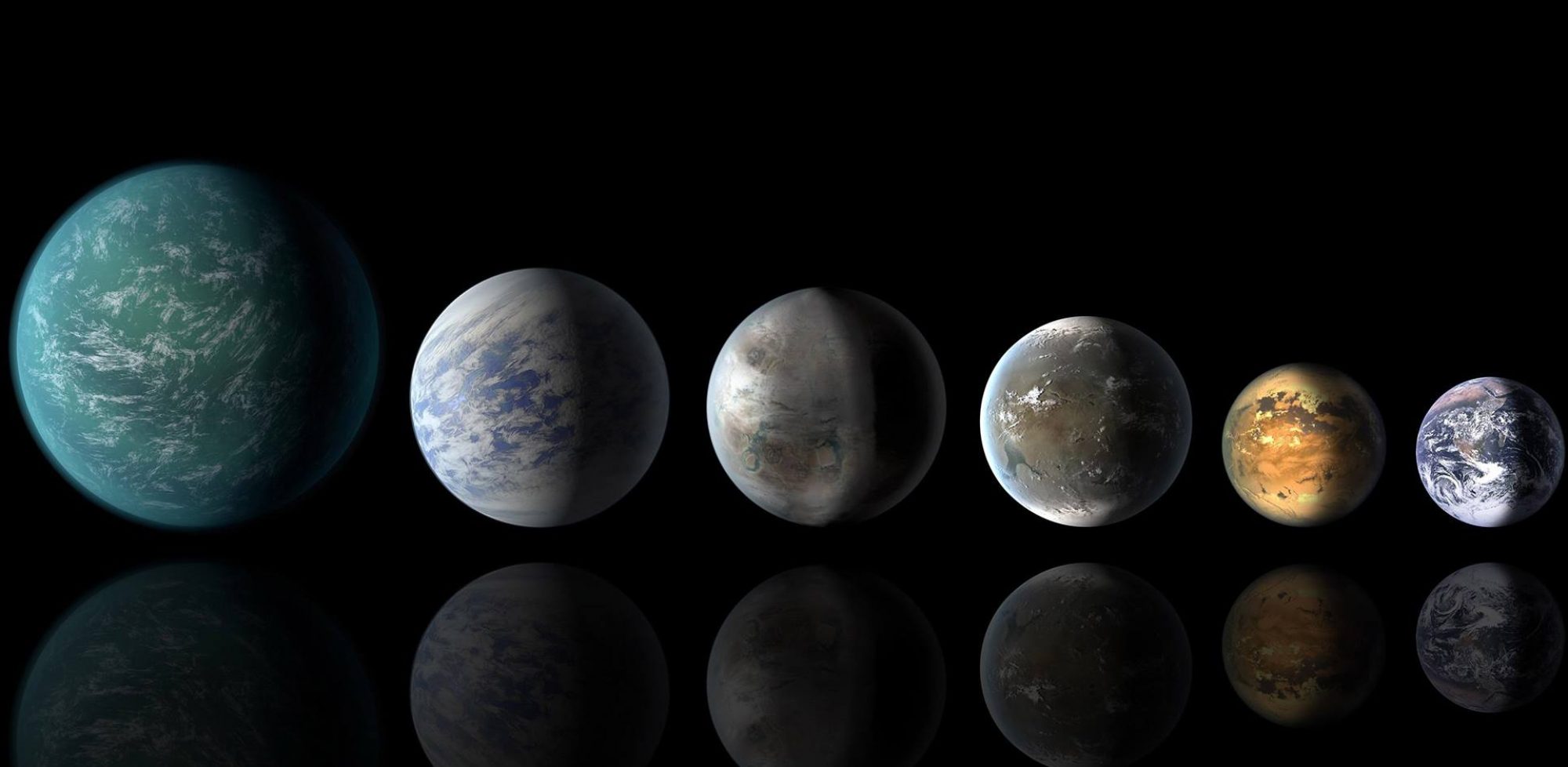
This Friday (October 19) at 10:45pm local time in French Guinea, a spacecraft is set to launch for Mercury. This is the BepiColombo mission which will begin its seven year journey to our solar system’s innermost planet. Surprisingly, the science goals for investigating this boiling hot world are intimately linked to habitability.
Mercury orbits the sun at an average distance of 35 million miles (57 million km); just 39% of the distance between the sun and the Earth. The planet therefore completes a year in just 88 Earth days.
The close proximity to the sun puts Mercury in a 3:2 tidal lock, meaning the planet rotates three times for every two orbits around the sun. (By contrast, our moon is in a 1:1 tidal lock and rotates once for every orbit around the Earth.) With only a tenuous atmosphere to redistribute heat, this orbit results in extreme temperatures between about -290°F and 800°F (-180°C to 427°C). The overall picture is one of the most inhospitable of worlds, so what do we hope to learn from this barren and baked land?
BepiColombo is a joint mission between the European Space Agency (ESA) and the Japan Aerospace Exploration Agency (JAXA). It consists of two orbiters, one built by each space agency. The mission is named after Giuseppe “Bepi” Colombo, an Italian mathematician who calculated the orbit of the first mission to Mercury —NASA’s Mariner 10— such that it could make repeated fly-bys of the planet.
When Mariner 10 reached Mercury in the mid-1970s, it made an astonishing discovery: the planet had a weak magnetic field. The Earth also has a magnetic field that is driven by movement in its molten iron core.
However, with a mass of only 5.5% that of the Earth, the interior of Mercury was expected to have cooled sufficiently since its formation for the core to have solidified and jammed the breaks on magnetic field generation. This is thought to have happened to Mars, which is significantly larger than Mercury with a mass around 10% that of the Earth. So how does Mercury hold onto its field?
The discoveries only got stranger with the arrival of NASA’s MESSENGER mission in 2011. MESSENGER discovery that Mercury’s magnetic field was off-set, with the center shifted northwards by a distance equal to 20% of the planet’s radius.
The mysteries also do not end with Mercury’s wonky magnetic field. The planet’s density is very high, suggesting a much larger iron core relative to its volume compared to the Earth.
The thin atmosphere is mysteriously rich in sodium and there also appears to be more volatiles such as water ice than is expected for a planet that dances so close to the sun. All this points to a formation and evolution that we do not yet understand.

The two BepiColombo orbiters will sweep around the planet to pick at these questions. The pair will get a global view of Mercury, in contrast to MESSENGER whose orbit did not allow a good view over the southern hemisphere.
“Getting data from the southern hemisphere to complement the details from MESSENGER is a logical next step to investigating the nature of Mercury’s magnetic field,” commented Masaki Fujimoto, Deputy Director General at JAXA’s Institute of Space and Astronautical Sciences (ISAS).
The European orbiter is the “Mercury Planetary Orbiter” (MPO), with “Bepi” as a nickname. Bepi will take a relatively close orbit around Mercury, with an altitude between 300 – 930 miles (480 – 1500 km). The main focus of the probe is the planet’s surface topology and composition, as well as a precise measurement of the gravitational field that reveals information about Mercury’s internal structure.
The Japanese orbiter is the “Mercury Magnetospheric Orbiter” (MMO) and was given the nickname “MIO” through a public contest held earlier this year and translates to “waterway” in Japanese.

“Water related names received many votes,” explained Go Murakami, BepiColombo MIO project scientist. “Because in the Japanese language, Mercury is written ‘水星’ (suisei) meaning ‘water planet’.”
The focus for MIO is Mercury’s magnetic field and the interaction with the solar wind; a stream of high energy particles that comes from the sun. This requires exploration of the region around Mercury and MIO will take a correspondingly wider orbit than Bepi, with an altitude between 250 – 7500 miles (400 – 12,000km).
While Mercury itself is interesting, understanding the planet’s history has wide ranging implications for the search for habitable worlds around other stars.
The easiest exoplanets to spot are those on close orbits around dim red dwarf (also known as M-dwarf) stars. As they are far less luminous than our sun, even planets on close orbits around red dwarfs may receive a similar level of radiation to the Earth, placing them in the so-called “habitable zone.” An important example of this are the TRAPPIST-1 worlds, whose three habitable-zone planets have orbits lasting 6, 9 and 12 Earth days.

However, the close proximity to the star comes with risks. Red dwarfs are particularly rambunctious, emitting flares that can strip the atmosphere of an orbiting planet. Mars is a classic example of this process.
Even orbiting a relatively quiet star at a distance further from the Earth, the thin atmosphere of Mars is being pulled away by the solar wind. Unless the TRAPPIST-1 worlds and those like them can protect their gases with a magnetic field, their surfaces may always be sterile.
While we know the Earth avoids this fate with its own magnetic field, it is not clear whether it would fare as well closer to the sun or with a weaker magnetic field. Mercury with its weak field and in the full blast of the solar wind offers an extreme comparison point.
A second insight Mercury could provide is that of the origin of rock. Planetary formation theories suggest there must have been mixing of dust grains in the planet-forming disc that circled the young sun. This would have shuffled up the elements that were condensing into solids at different temperatures within the disc. The exact nature and result of the shuffling remains a big question, yet it controls the composition of inner rocky planets that includes the Earth.
“The subject of planetary origins is very intriguing to me,” remarks Fujimoto. “JAXA’s asteroid sample return mission, Hayabusa2, is asking the question of where the water on Earth came from. BepiColombo will ask the complimentary question of how our planet’s rocky body was made.”
Together, the two orbiters cover a wide range of science of addressing these questions. They can also work as a pair by taking simultaneous measurements from different locations. This is particularly useful for analyzing time-varying events and also allows the planetary magnetic field to be separated out from the magnetic field carried by the solar wind.
The launch date for BepiColombo has been pushed back several times over the last few years. However, this has allowed for engineering improvements, and discoveries such as the TRAPPIST-1 planets have only added to the excitement of the mission.
“We are not unhappy about the launch delays,” said Fujimoto. “What has happened in planetary science during that period has made the expectation for BepiColombo even higher!”
The journey to the innermost planet is not a quick one. Due to arrive in 2025, the long duration is actually not due to distance but the need to brake. The pull from the sun’s gravity at such close proximity makes it hard for BepiColombo to slow sufficiently for the two probes to enter Mercury’s orbit.
The spacecraft therefore does nine planetary fly-bys; one by the Earth in April next year, then two for Venus and six for Mercury. The gravity of the planet can be used to slow down the spacecraft and allow Bepi and MIO to begin their main mission.
To my complete delight, ESA have started an animated series of shorts for the mission, similar to the cartoons for the Rosetta mission to comet 67P in 2014. These informative little videos depict the adventures of Bepi, MIO and the Mercury Transfer Module (MTM) that provides the propulsion to reach Mercury.
In addition to the videos, all three probes (and the mission itself) have twitter accounts @BepiColombo (main mission account), @esa_bepi (character account for Bepi which tweets in English), @jaxa_mmo (character account for MIO that tweets in English and Japanese) and @esa_mtm that tweets in… I’ll let you find that out!
The live launch feed from ESA is due to begin at 21:38 EDT on Friday, October 19. Good luck, BepiColombo!
